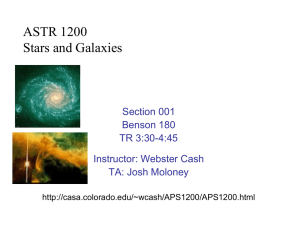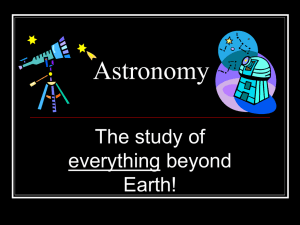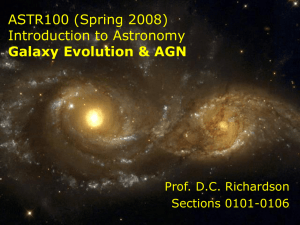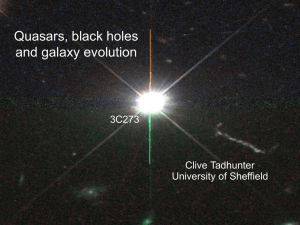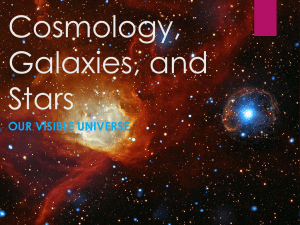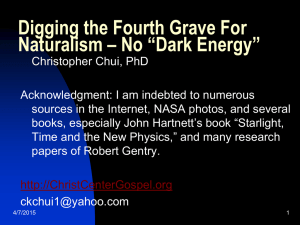Star formation in galaxies over the last 10 billion
advertisement
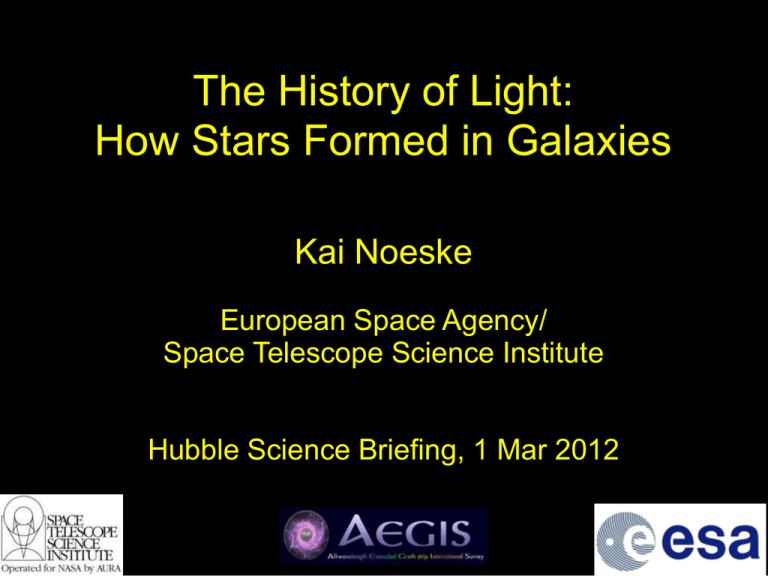
The History of Light: How Stars Formed in Galaxies Kai Noeske European Space Agency/ Space Telescope Science Institute Hubble Science Briefing, 1 Mar 2012 What is a Galaxy? 2 The Milky Way 100 Billion Stars like our sun 3 The Milky Way www.atlasoftheuniverse.com 4 Meet the Neighbors. M31 (“Andromeda Galaxy”), our close neighbor and similar to the Milky Way M51 (“Whirlpool Galaxy”) M104 (“Sombrero Galaxy”) 5 6 Stars are not evenly distributed in the universe. Stars are born and live in galaxies. Most galaxies have billions of stars. There are billions of galaxies in the known universe. Did they always look the same? 7 A long time ago in galaxies far, far away: The HST Ultra Deep Field 8 A long time ago in galaxies far, far away: The HST Ultra Deep Field 9 A long time ago in galaxies far, far away: The HST Ultra Deep Field 10 Two immediate results: I. Galaxies formed at some point in the distant past II. Galaxies evolved with time Where do the Stars and Galaxies come from? 11 Timeline (very rough) ● ● Most galaxies have very old stars Most galaxies started forming their stars some 10-13 Billion years ago, shortly after the beginning of the Universe 12 3.2% 22% 74% 13 The Cosmic Microwave Background: a baby photo of the Universe when it was just 300,000 years old It reveals tiny irregularities; the density of matter varied by parts in a million 14 Dark Matter is more abundant, and dominates gravity. To understand how gravity created structure (galaxies) from the early homogeneous Universe, we need to simulate Dark Matter. Outcome depends strongly on the structure/geometry of the Universe and the content of Dark Matter 15 Supercomputer simulations of Dark Matter: gravity grows the initial density perturbations, structure forms From http://cosmicweb.uchicago.edu/filaments.html Quic kTime™ and a Y UV 420 c odec dec ompr es sor are needed to s ee t his pic tur e. choose a “rotating box” version such as http://cosmicweb.uchicago.edu/images/mov/s02_0.gif 16 Gravity grows a “Cosmic Web” of Dark Matter - voids, filaments, clusters of clumps that host galaxies Simulation: A.Kravtsov 17 Gravity grows a “Cosmic Web” of Dark Matter - voids, filaments, clusters of clumps that host galaxies Galaxies form from overdense regions Simulation: A.Kravtsov 18 Luminous matter, formation of gas disk and stars: Luminous matter (gas!) is viscous, and heated as it falls into dark matter halos; then heat is radiated away gas cools - contracts angular momentum is conserved >spin-up of rotation (“figure skater”) fast rotating disk energy in turbulent/random motions (perpendicular to disk) is dissipated (viscosity->friction->heating ->heat is radiated away) -> motions perpendicular to ordered rotation disappear ->cold, dense gas disk -> STARS 19 Recap: From Dark Matter to Stars 1) The Universe contains mostly Dark Matter 2) Tiny irregularities in the Dark Matter density in the early Universe grew rapidly through gravity 3) Gas fell into the resulting Dark Matter clumps/”halos” (galaxies) and formed cold, dense gas disks 4) Stars are born and live in galaxies because they need cold, dense gas to form 20 Hierarchical galaxy formation; disks merge to disk bulges and Ellipticals In a “hierarchical” scenario, smaller structures form first, and later merge into bigger ones: -Galaxies merge to form larger ones -Mergers of roughly equal-sized galaxies often (not always) turn Spirals into Ellipticals Bertola et al. Halo; Blue: Dark matter yellow: gas; red: stars 21 Galaxy interactions/mergers: Observations and Numerical simulations http://www.youtube.com/watch?v=agqLEbOFT2A&feature=youtu.be Credits: Patrik Jonsson, Greg Novak & Joel Primack, University of California, Santa Cruz 22 QuickTime™ and a decompressor are needed to see this picture. 23 QuickTime™ and a decompressor are needed to see this picture. 24 QuickTime™ and a decompressor are needed to see this picture. 25 QuickTime™ and a decompressor are needed to see this picture. 26 II. How did we learn about galaxy formation? 27 New Sky Surveys at many Wavelengths 28 Multiwavelength surveys: combined efforts to get the whole picture. A new era of astronomy: big collaborations, huge databases 29 Multiwavelength surveys: combined efforts to get the whole picture. A new era of astronomy: big collaborations, huge databases HST (visual, near infrared) SPITZER (infrared) Dust, star form., black holes... GALEX (UV) Chandra (X-ray) star formation XMM (X-ray) DEEP2 (KECK,DEIMOS) VLA (radio) (gas, mass, black holes, star formation) Redshift, dynamics, ... 30 Astronomers can look back in time: light from very distant galaxies took billions of years to reach us. Looking far is looking back even more distant galaxy distant galaxy nearby galaxy Text Long (billions of years) time light travels to reach us Short (millions of years) 31 Astronomers can look back in time: light from very distant galaxies took billions of years to reach us. Looking far is looking back even more distant galaxy distant galaxy nearby galaxy Text Long (billions of years) time light travels to reach us Short (millions of years) 32 Astronomers can look back in time: light from very distant galaxies took billions of years to reach us. Looking far is looking back even more distant galaxy distant galaxy nearby galaxy Text Long (billions of years) time light travels to reach us Short (millions of years) 33 Astronomers can look back in time: light from very distant galaxies took billions of years to reach us. Looking far is looking back even more distant galaxy distant galaxy nearby galaxy Text Long (billions of years) time light travels to reach us Short (millions of years) 34 Large telescopes on the ground: Spectroscopy gives each galaxy a “time stamp” 35 DEIMOS spectrograph on the Keck II telescope Built by Sandra Faber & team, UC Santa Cruz Can observe spectra of hundreds of distant galaxies at a time 36 Overlapping slitmask layout 37 120 spectra of distant galaxies emission lines of ionized gas wavelength The emission lines are at longer wavelengths than measured in the lab: They are “redshifted”. This is because distant galaxies move away from us (“Doppler effect”, expansion of the Universe). wavelength The redshift (=velocity) measures the distance and how far we look back in time 38 For galaxies in the early universe, the infrared matters: 39 UV Visible Light Infrared spectral flux Nearby Galaxy (not redshifted) young stars (starbirth) older stars Distant Galaxy (redshifted) young stars (starbirth) older stars wavelength For distant galaxies, light from young stars (UV) and older stars (visible) is redshifted to long wavelengths (Infrared) 40 The Spitzer Space Telescope provided infrared data: pierce through the dust, measure star formation rates Spitzer Extended Deep Survey Reduction: M. Ashby 41 Hubble & JWST Probe the Early Universe HST: currently the most sensitive telescope in the short-wavelength infrared (nearinfrared): Can observe redshifted UV (star formation) from the most distant galaxies JWST (launch: 2018) will be more sensitive, and reach longer infrared wavelengths: will reach even further back in time, and observe redshifted visible & infrared light in earliest galaxies 42 JWST will have much improved sensitivity to faint distant galaxies: First Stars & Galaxies Small galaxies across cosmic time ... HST Ultra Deep Field JWST Ultra Deep Field Simulation 43 Star formation in galaxies over the last 10 billion years Space Density of Star Formation 10 Billion yrs ago Space Density of Star Formation now Hopkins & Beacom 2006 now 10 Billion yrs ago Big Galaxies Small Galaxies Heavens et al. 2004 44 Star formation in galaxies over the last 10 billion years Space Density of Star Formation 10 Billion yrs ago Space Density of Star Formation now Hopkins & Beacom 2006 now 10 Billion yrs ago Big Galaxies Small Galaxies Heavens et al. 2004 Co-moving star formation rate (SFR) density declined by ~x10 Galaxy star formation histories are massdependent: massive galaxies formed bulk of stars quickly and early, less massive galaxies formed on longer timescales (“Downsizing”) 45 Star formation in galaxies over the last 10 billion years Space Density of Star Formation 10 Billion yrs ago Space Density of Star Formation now now 10 Billion yrs ago Big Galaxies Small Galaxies Heavens et al. 2004 Hopkins & Beacom 2006 Co-moving star formation rate (SFR) density declined by ~x10 Galaxy star formation histories are massdependent: massive galaxies formed bulk of stars quickly and early, less massive galaxies formed on longer timescales (“Downsizing”) Reason for declining star formation: Galaxies run out of gas! 46 today billions of years ago rapid star birth & gas consumption big galaxies (image: Driver 1998) small galaxies 47 today billions of years ago rapid star birth & gas consumption big galaxies slow star birth & gas consumption (image: Driver 1998) small galaxies 48 today billions of years ago rapid star birth & gas consumption big galaxies slow star birth & gas consumption (image: Driver 1998) small galaxies 49 today billions of years ago rapid star birth & gas consumption big galaxies slow star birth & gas consumption (image: Driver 1998) small galaxies 50 http://hubblesite.org http://candels.ucolick.org http://aegis.ucolick.org http://www.atlasoftheuniverse.com/ noeske@stsci.edu 51 Questions? 52

